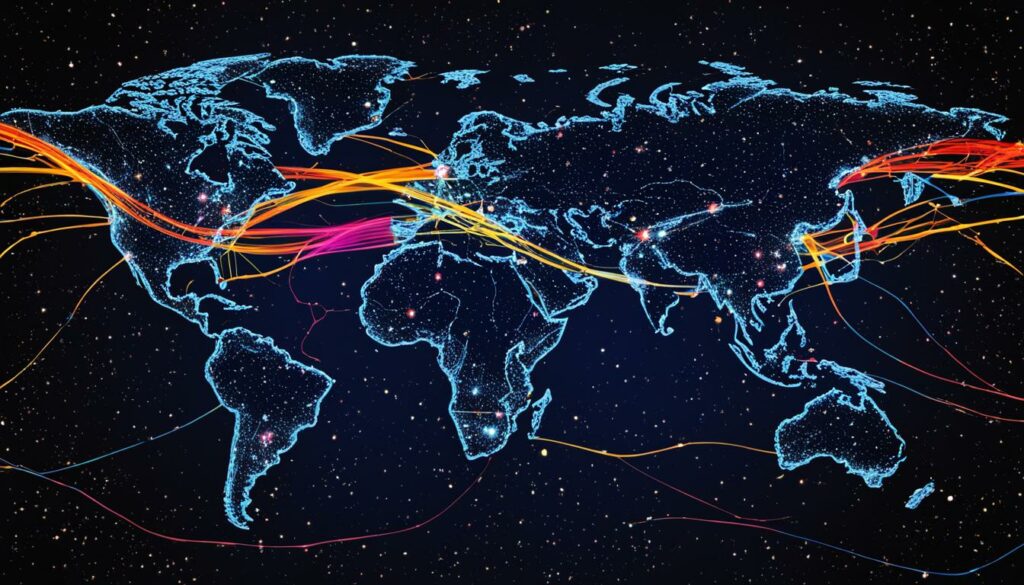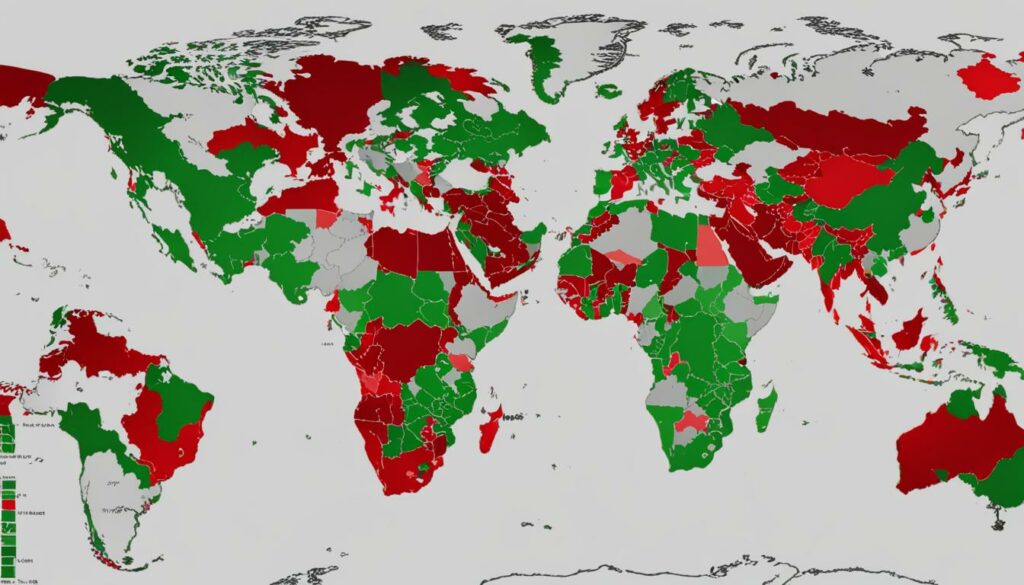If you’ve ever wondered how devices communicate with each other over a network, the answer lies in the Internet Protocol (IP). The IP is a set of rules that enable seamless communication between devices, and it comes in two main versions: IPv4 and IPv6. In this article, we’ll explore the differences between these two IP protocol versions and understand why it’s essential to grasp their distinctions for the future of internet connectivity.
Key Takeaways:
- IPv4 and IPv6 are two versions of the Internet Protocol with distinct features and addressing formats.
- IPv4 uses a 32-bit address format, while IPv6 uses a 128-bit address format. IPv6 offers significantly more unique addresses.
- IPv6 includes built-in Quality of Service (QoS) and network security features that IPv4 lacks, eliminating the need for Network Address Translation (NAT).
- While IPv6 adoption is growing, IPv4 remains the dominant protocol, but IPv6 availability accounts for approximately 32% of all internet traffic worldwide.
- Understanding the differences between IPv4 and IPv6 is crucial for the continued growth and scalability of the internet.
Now that you have a basic understanding of IPv4 and IPv6, let’s dive deeper into the specifics of each protocol version to uncover their unique characteristics.
If you’re looking for WordPress Hosting that delivers optimal performance, we recommend BoostedHost. Sign up now through this link: www.boostedhost.com/wordpress-hosting.
What Is the Internet Protocol (IP)?
The Internet Protocol (IP) is a set of rules that helps with routing packets of data across networks and ensuring they reach the correct destination. When you send information from your computer, it is broken down into smaller packets, each containing IP information. Every device or domain on the Internet is assigned a unique IP address that identifies it from other devices. This addressing system allows networks to effectively route data packets and ensure they reach the right destination.
For example, imagine you want to visit a website. When you type the website’s URL into your browser, your computer communicates with a nearby router, which looks at the IP address you entered and consults its routing table to determine the best path for your data to reach the website’s server.
Each router along the way reads the IP information in the packets and forwards them to the next hop until they reach the destination server. This process is known as “packet routing.” Without IP, your data packets wouldn’t know where to go, and your online activities would come to a standstill.
In summary, the Internet Protocol (IP) is essential for the functioning of the internet. It ensures that data packets are correctly routed from source to destination, allowing you to browse websites, send emails, stream videos, and perform countless other online activities.
| IPv4 | IPv6 | |
|---|---|---|
| Address Format | 32-bit | 128-bit |
| Address Space | Approximately 4.3 billion addresses | Infinitely more addresses |
| Features | Basic addressing and routing capabilities | Built-in Quality of Service (QoS) and network security features |
The table above highlights some of the key differences between IPv4 and IPv6. While IPv4 has a limited address space and basic features, IPv6 offers an exponentially larger address space and additional capabilities, making it a fundamental technology for the future of the internet.
Fun Fact:
The first version of the Internet Protocol, IPv4, was standardized in 1983.
Now that you understand the basics of the Internet Protocol (IP), let’s dive deeper into IPv4 in the next section.
What Is IPv4?
IPv4, launched in 1983, is the first version of the Internet Protocol (IP). It uses a 32-bit address format, which is the format most people are familiar with when it comes to IP addresses. With IPv4, approximately 4.3 billion unique addresses can be generated, although certain IP blocks are reserved for special uses. A typical example of an IPv4 address is 192.168.10.150.
Understanding IPv4 is crucial to grasp the fundamentals of IP addressing. IPv4 plays a vital role in ensuring communication between devices on a network. Its 32-bit address structure has been the backbone of the internet for many years, allowing devices to connect, exchange data, and access information.
| IPv4 | 32-Bit Address | IP Address |
|---|---|---|
| First Version | Familiar Format | 4.3 Billion Unique Addresses |
| IPv4 Address Example: | 192.168.10.150 | |
“IPv4, with its 32-bit address format, has been the foundation of the internet for decades. Its simplicity and familiarity have allowed for widespread adoption and effective communication between devices.”
What Is IPv6?
IPv6 is the next generation of Internet Protocol designed to overcome the limitations of its predecessor, IPv4. Unlike IPv4, which uses a 32-bit address format, IPv6 utilizes a much larger 128-bit address format. This substantial increase in address space allows for an unimaginable number of unique IP addresses, ensuring the accommodation of the growing number of devices and networks.
An IPv6 address is represented by eight groups of four hexadecimal digits, separated by colons. Alphanumeric characters are also used in IPv6 addresses, making them more versatile and flexible compared to traditional IPv4 addresses.

IPv6 not only provides a virtually infinite supply of IP addresses but also introduces significant improvements in network performance, security, and routing efficiency. Its larger address space eliminates the need for Network Address Translation (NAT) and allows for seamless end-to-end connectivity at the IP layer.
To fully grasp the magnitude of IPv6’s expanded address space, consider the following example:
If the total number of IPv4 addresses can be compared to a small town with limited housing options, the number of IPv6 addresses can be likened to an entire planet, providing ample space for countless cities and inhabitants.
To illustrate the structure of an IPv6 address, let’s take a look at an example:
| IPv6 Address | 3002:0bd6:0000:0000:0000:ee00:0033:6778 |
|---|
Key Features of IPv6:
- 128-bit address format
- Alphanumeric characters included
- 1,028 times more addresses than IPv4
- End-to-end connectivity without NAT
- Improved network performance and security
- Efficient routing capabilities
With its immense address space, enhanced features, and seamless connectivity, IPv6 is the future of the Internet Protocol, driving the growth and scalability of the internet as we continue to advance into an increasingly connected world.
Difference Between IPv4 vs IPv6
When comparing IPv4 and IPv6, the most noticeable difference is the address format. IPv4 utilizes a 32-bit address format, while IPv6 adopts a 128-bit address format. This disparity in address length results in IPv6 providing a significantly larger number of unique addresses than IPv4.
But the dissimilarities don’t stop there. IPv6 offers several technical advancements that IPv4 lacks. One noteworthy aspect is the inclusion of built-in Quality of Service (QoS) and network security features, which enhance performance and safeguard data transmission.
Another key difference is that IPv6 eliminates the need for Network Address Translation (NAT), allowing for direct end-to-end connectivity at the IP layer. This direct connectivity simplifies network configurations and promotes a more efficient and scalable network infrastructure.
Moreover, IPv6 has larger packet headers than IPv4, enabling the incorporation of additional features and information. Additionally, IPv6 includes multicast as part of its base specifications, allowing for efficient group communication.
“IPv4 uses a 32-bit address format, while IPv6 uses a 128-bit address format. IPv6 offers significantly more unique addresses than IPv4. Furthermore, IPv6 incorporates QoS and network security features, eliminates the need for NAT, allows for end-to-end connectivity, and has larger packet headers with multicast capabilities.”
| IPv4 | IPv6 |
|---|---|
| 32-bit address format | 128-bit address format |
| Approximately 4.3 billion unique addresses | An infinite number of unique addresses |
| No built-in QoS or network security features | Built-in QoS and network security features |
| Requires NAT for connecting to the internet | Enables direct end-to-end connectivity |
| Smaller packet headers | Larger packet headers |
| No multicast capabilities | Includes multicast as part of the base specifications |
Number of Addresses in IPv4 vs IPv6
When it comes to the number of addresses, there is a significant difference between IPv4 and IPv6. IPv4, with its 32-bit address format, supports approximately 4.3 billion addresses. While this may seem like a large number, it is quickly being depleted as the demand for IP addresses continues to grow. In contrast, IPv6, with its 128-bit address format, supports an infinite number of addresses. This immense address space ensures that there will be more than enough unique addresses to accommodate the ever-expanding number of devices and networks.
Let’s take a closer look at the numbers:
| IP Version | Address Format | Number of Addresses |
|---|---|---|
| IPv4 | 32-bit | Approximately 4.3 billion |
| IPv6 | 128-bit | Infinite |
As you can see, the 32-bit address space of IPv4 restricts the number of available addresses, leading to the exhaustion of IPv4 addresses. On the other hand, the 128-bit address space of IPv6 provides a vast pool of addresses that can easily accommodate the growing demand for connectivity.
Image:

IPv4 supports approximately 4.3 billion addresses, while IPv6 supports an infinite number of addresses.
The transition from IPv4 to IPv6 is crucial in ensuring the future scalability of the internet. Adopting IPv6 allows for a virtually limitless number of unique addresses, paving the way for the continued growth of devices, networks, and the Internet of Things. It is clear that the transition to IPv6 is not just a matter of preference but a necessity to meet the demands of our increasingly connected world.
Speed Comparison: IPv4 vs IPv6
In the ongoing debate of IPv4 vs IPv6, one important aspect that often comes up is the speed comparison between the two protocols. Many wonder if there is a notable difference in speeds when accessing websites or services over IPv4 or IPv6.
Tests conducted have shown that, in general, there is no significant difference in speed between IPv4 and IPv6. The performance of accessing online platforms and services remains comparable across both protocols.
While some evidence suggests that IPv6 might be slightly faster in certain scenarios, it is essential to consider the variables involved in making a definitive comparison. Factors such as Network Address Translation (NAT) in IPv4 and larger packet headers in IPv6 contribute to potential speed differences.
“IPv6 might offer a minor advantage in terms of speed due to its built-in network features and improved packet handling capabilities. However, the impact of these factors can vary depending on the specific network setup and configuration.”
Understanding the intricacies of speed comparisons between IPv4 and IPv6 requires a comprehensive analysis of the network environment, including the presence of NAT and the efficiency of packet transmissions.
IPv4 vs IPv6 Adoption
While IPv4 is still the most widely-used Internet Protocol, IPv6 adoption is steadily increasing worldwide. Adoption rates vary across countries, with some nations embracing IPv6 more than others. For instance, the United States boasts over 41% IPv6 adoption, while the United Kingdom sits at around 30% adoption.
Overall, IPv6 availability accounts for approximately 32% of all internet traffic globally.
| Country | IPv6 Adoption |
|---|---|
| United States | 41% |
| United Kingdom | 30% |
Table: IPv6 Adoption by Country
These numbers indicate a growing recognition of the advantages and importance of IPv6 in supporting the expansion of internet connectivity. As more devices and networks join the online ecosystem, IPv6 adoption becomes crucial for accommodating the increasing demand.
As IPv6 adoption continues to rise, it is essential for businesses and individuals to stay up-to-date with the evolving internet landscape. Embracing IPv6 will pave the way for seamless connectivity and ensure a smoother transition into the future.

Conclusion
In conclusion, when it comes to the Internet Protocol, IPv4 and IPv6 are the two main versions that offer different features and addressing capabilities. While IPv4 has been the dominant protocol for many years, IPv6 was developed to address the limitations of IPv4, especially the limited number of unique addresses it can provide. With the increasing number of devices and the continuous growth of the internet, the adoption of IPv6 is crucial in order to ensure scalability and optimal performance.
IPv6 not only offers a larger address space, with its 128-bit address format, but it also includes built-in features like Quality of Service (QoS) and network security, which are lacking in IPv4. Moreover, IPv6 eliminates the need for Network Address Translation (NAT) and allows for end-to-end connectivity at the IP layer, streamlining communication between devices and networks.
To keep up with the evolving internet landscape and future-proof your online presence, it is recommended to consider adopting IPv6. By embracing IPv6, you can ensure that your network can accommodate the growing number of devices and maintain optimal performance. If you’re looking for reliable WordPress hosting that supports IPv6, we recommend BoostedHost. Sign up now through this link for an exceptional hosting experience.
FAQ
Q: What is the Internet Protocol (IP)?
A: The Internet Protocol (IP) is a set of rules that helps with routing packets of data across networks and ensuring they reach the correct destination. It allows devices to communicate with each other over a network.
Q: What is IPv4?
A: IPv4 is the first version of IP that uses a 32-bit address format. It provides approximately 4.3 billion unique addresses.
Q: What is IPv6?
A: IPv6 is a newer version of IP that uses a 128-bit address format. It offers 1,028 times more addresses than IPv4 and includes alphanumeric characters.
Q: What is the difference between IPv4 and IPv6?
A: The main difference is the address format. IPv4 uses a 32-bit address format, while IPv6 uses a 128-bit address format. IPv6 also includes built-in Quality of Service (QoS) and network security features that IPv4 does not have.
Q: How many addresses do IPv4 and IPv6 support?
A: IPv4 supports approximately 4.3 billion addresses, while IPv6 supports an infinite number of addresses. The 32-bit address space in IPv4 limits the number of unique addresses, while the 128-bit address space in IPv6 provides a vast pool of addresses.
Q: Is there a speed difference between IPv4 and IPv6?
A: In general, there is no significant difference in speed between IPv4 and IPv6. Tests have shown that the speed of accessing websites or services over both protocols is comparable.
Q: How widely adopted is IPv6?
A: IPv4 is still the most widely used Internet Protocol, but IPv6 adoption is increasing worldwide. IPv6 availability accounts for approximately 32% of all internet traffic worldwide.












